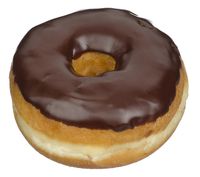Where did all my donuts go?
Did you know that ~148 trillion calories were lost last year in the US Midwest soybean and wheat crop because a single enzyme couldn’t tell the difference between oxygen and carbon dioxide (Walker et al. 2016)? If we converted these calories into donuts, this would be enough donuts to fill up the Dead Sea every two years if we stacked the donuts in tidy towers. Or more than enough donuts to give every member of the European Union a donut a day for a year. Or enough donuts to stretch back and forth between the earth and the moon eleven times. Or enough donuts to…well, you get the idea: That is a lot of donuts, and if you are like me you are probably wondering where all these donuts went, and what we can do about it.
You probably recall from high school biology that plants “breathe in” carbon dioxide and “breathe out” oxygen using light energy from the sun in the process of photosynthesis. The carbon dioxide that they breathe in is used to make sugars, which form the building blocks for the plant itself and the food it makes for us.
The first enzyme that captures carbon dioxide and starts the process of sugar production is called Rubisco. Rubisco reacts with carbon dioxide to produce a molecule that can be used to make sugar. It turns out that it is hard for an enzyme to work quickly and be specific for carbon dioxide at the same time, and so Rubisco also reacts with oxygen and makes a molecule that not only can’t make sugar but is also toxic to the plant. To survive, plants must recycle this toxic molecule into something that’s safe but like any recycling program this process isn’t free. Photorespiration is the process that recycles this toxic molecule and proceeds at great energy and carbon expense to the plant, resulting in decreased production and yield.
Within CEPLAS, we are investigating ways to make the recycling process of photorespiration more efficient. Photorespiration is a complex process with many steps that occur between four different compartments of each plant cell doing photosynthesis. In order to understand and optimize this complex process, we are exploring complementary experimental and computational approaches. Our experimental approaches involve removing specific steps of photorespiration to determine if there are alternative pathways by which the recycling can occur. Additionally, by mathematically modeling photorespiration we are able to better understand how this recycling operates and test hypothetical alternative pathways to see if they are more efficient. Our hope is that one day we will be able to help plants yield more with fewer resources, meaning that the world will not only have more donuts, but more importantly food, fuel and fiber for a growing population.
Dr. Berkley Walker, Institute of Plant Biochemistry, Heinrich Heine University Düsseldorf
Planter’s Punch
Under the heading Planter’s Punch we present each month one special aspect of the CEPLAS research programme. All contributions are prepared by our young researchers.
Further Reading
Walker BJ, VanLoocke A, Bernacchi CJ, Ort DR (2016) The costs of photorespiration to food production now and in the future. Annual Review of Plant Biology 67 (1):107-129. doi:10.1146/annurev-arplant-043015-111709
About the Author

The article was written by Berkley Walker, who is a member of the CEPLAS Postdoc Programme. Berkley is determining alternative sources of photorespiratory carbon loss in Arabidopsis thaliana. Findings from his work will facilitate the prediction of global plant CO2 exchange and the identification of novel routes for improving net photosynthesis of C3 crop plants.
